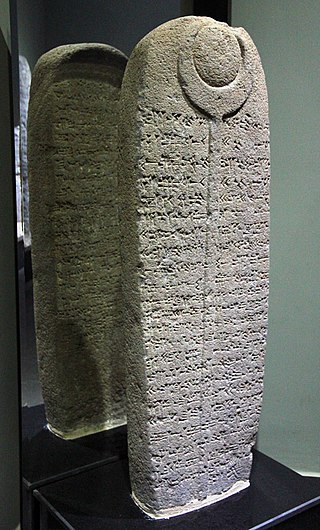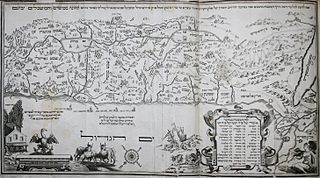Related Research Articles
The Book of Kings is a book in the Hebrew Bible, found as two books in the Old Testament of the Christian Bible. It concludes the Deuteronomistic history, a history of Israel also including the books of Joshua, Judges and Samuel.

The Kingdom of Judah was a Semitic-speaking kingdom of the Southern Levant during the Iron Age. Centered in the highlands of Judea, the kingdom's capital was Jerusalem. Jews are named after Judah and are primarily descended from it.

Baasha was, according to the Hebrew Bible, the third king of the northern Israelite Kingdom of Israel. He was the son of Ahijah of the Tribe of Issachar. Baasha's story is told in 1 Kings 15:16–16:7.

Aram was a historical region mentioned in early cuneiforms and in the Bible, populated by Arameans. The area did not develop into a larger empire but consisted of a number of small states in present-day Syria and northern Israel. Some of the states are mentioned in the Old Testament, Damascus being the most outstanding one, which came to encompass most of Syria. Furthermore, Aram-Damascus is commonly referred to as simply Aram in the Old Testament.

Asa was, according to the Hebrew Bible, the third king of the Kingdom of Judah and the fifth king of the House of David. Based on the Biblical chronology, Biblical scholars suggest that he reigned from the late 10th to early 9th century BCE. He was succeeded by Jehoshaphat, his son. According to Edwin R. Thiele's chronology, when Asa became very ill, he made Jehoshaphat coregent. Asa died two years into the coregency.

Hazael was an Aramean king who is mentioned in the Bible. Under his reign, Aram-Damascus became an empire that ruled over large parts of Syria and Israel. While he was likely born in the greater Damascus region of today, his exact place of birth is still controversial, with both Bashan and the Beqaa Valley being favoured by different historians.

Hadadezer ; also known as Adad-Idri, and possibly the same as Bar-Hadad II (Aram.) or Ben-Hadad II (Heb.), was the king of Aram at Damascus between 865 and 842 BC.

The Kingdom of Aram-Damascus was an Aramean polity that existed from the late-12th century BCE until 732 BCE, and was centred around the city of Damascus in the Southern Levant. Alongside various tribal lands, it was bounded in its later years by the polities of Assyria to the north, Ammon to the south, and Israel to the west.
Benhadad,Ben Hadad,Ben-hadad or Benadad, may refer to:
Ben-Hadad I, son of Tabrimmon and grandson of Hezion, was king of Aram-Damascus between 885 BCE and 865 BCE. Ben-Hadad I was reportedly a contemporary of kings Baasha of the Kingdom of Israel and Asa of the Kingdom of Judah.

The Qedarites were a largely nomadic ancient Arab tribal confederation centred in the Wādī Sirḥān in the Syrian Desert. Attested from the 9th century BC, the Qedarites formed a powerful polity which expanded its territory over the course of the 9th to 7th centuries BC to cover a large area in northern Arabia stretching from Transjordan in the west to the western borders of Babylonia in the east, before later moving westwards during the 6th to 5th centuries BC to consolidate into a kingdom stretching from the eastern limits of the Nile Delta in the west till Transjordan in the east and covering much of southern Palestine, the Sinai Peninsula and the Negev.
Rezon the Syrian, also named "Ezron", was an enemy of King Solomon mentioned in 1 Kings 11. Some 19th-century scholars considered Rezon to be the throne name of King Hezion. He is known only from the Hebrew Bible.

The Pazarcık Stele is an Assyrian monument which functioned as a boundary stone erected by the Assyrian king Adad-nirari III in 805 BC to demarcate the border between the kingdoms of Kummuh and Gurgum. The reverse and obverse of the stele have been inscribed in the Akkadian language in different times.

2 Kings 16 is the sixteenth chapter of the second part of the Books of Kings in the Hebrew Bible or the Second Book of Kings in the Old Testament of the Christian Bible. The book is a compilation of various annals recording the acts of the kings of Israel and Judah by a compiler in the seventh century BCE with a supplement added in the sixth century BCE. This chapter records the events during the reign of Ahaz, the king of Judah.

2 Kings 8 is the eighth chapter of the second part of the Books of Kings in the Hebrew Bible or the Second Book of Kings in the Old Testament of the Christian Bible. The book is a compilation of various annals recording the acts of the kings of Israel and Judah by a Deuteronomic compiler in the seventh century BCE, with a supplement added in the sixth century BCE. This chapter records Elisha's acts in helping the family of Shunammite woman to escape famine, then to gain back their land and in contributing to Hazael's ascension to the throne of Syria (Aram) in verses 7–15; then subsequently records the reigns of Joram and Ahaziah, the kings of Judah.

2 Kings 13 is the thirteenth chapter of the second part of the Books of Kings in the Hebrew Bible or the Second Book of Kings in the Old Testament of the Christian Bible. The book is a compilation of various annals recording the acts of the kings of Israel and Judah by a Deuteronomic compiler in the seventh century BCE, with a supplement added in the sixth century BCE. This chapter records the reigns of Jehu's son, Jehoahaz, and Jehu's grandson, Jehoash, in the kingdom of Israel during the reign of Jehoash, the king of Judah, as well as the events around the death of Elisha. The narrative is a part of a major section 2 Kings 9:1–15:12 covering the period of Jehu's dynasty.

The Melqart stele, also known as the Ben-Hadad or Bir-Hadad stele is an Aramaic stele which was created during the 9th century BCE and was discovered in 1939 in Roman ruins in Bureij Syria. The Old Aramaic inscription is known as KAI 201; its five lines reads:
“The stele which Bar-Had-
-ad, son of [...]
king of Aram, erected to his Lord Melqar-
-t, to whom he made a vow and who heard his voi-
-ce.”

1 Kings 22 is the 22nd chapter of the First Book of Kings in the Old Testament of the Christian Bible or the first part of Books of Kings in the Hebrew Bible. The book is a compilation of various annals recording the acts of the kings of Israel and Judah by a Deuteronomic compiler in the seventh century BCE, with a supplement added in the sixth century BCE. This chapter belongs to the section comprising 1 Kings 16:15 to 2 Kings 8:29 which documents the period of Omri's dynasty. The focus of this chapter is the reign of king Ahab and Ahaziah in the northern kingdom, as well as of king Jehoshaphat in the southern kingdom.

2 Chronicles 16 is the sixteenth chapter of the Second Book of Chronicles the Old Testament in the Christian Bible or of the second part of the Books of Chronicles in the Hebrew Bible. The book is compiled from older sources by an unknown person or group, designated by modern scholars as "the Chronicler", and had the final shape established in late fifth or fourth century BCE. This chapter belongs to the section focusing on the kingdom of Judah until its destruction by the Babylonians under Nebuchadnezzar and the beginning of restoration under Cyrus the Great of Persia. The focus of this chapter is the reign of Asa, king of Judah.

The Tribe of Naphtali was one of the northernmost of the twelve tribes of Israel. It is one of the ten lost tribes.
References
- ↑ The New Unger's Bible Dictionary Merrill F. Unger, Roland Kenneth Harrison, R. K. Harrison - 2006 "This important royal inscription in general confirms the order of early Syrian rulers as given in 1 Kings 15:18, where Ben-hadad is said to be the “son of Tabrimmon, the son of Hezion, king of Aram, who lived in Damascus."
- ↑ "On the reliability of the Old Testament K. A. Kitchen - 2003 p 8 and 30, dates Ben-Hadad I within 910-887, and "A Survey of the Old Testament", Hill and Walton provide a chart comparing various scholars with Asa's final dates no later than 866"
- ↑ "Samsi-ilu, a "strong man" in Assyria, during the reigns of Shalmaneser IV, Assur-dan III and Assur-nirari V. ... probably ordered by the new king under the strong influence of Samsi-ilu."
- ↑ The Book of Amos in Emergent Judah p173 Jason Radine - 2010 "Samsi-ilu fought against Hezion of Damascus and apparently extracted tribute from him in 773/2, but Damascus appears to have remained independent. 10 This period, the middle two quarters of the eighth century, was proposed by Wolff as ..."